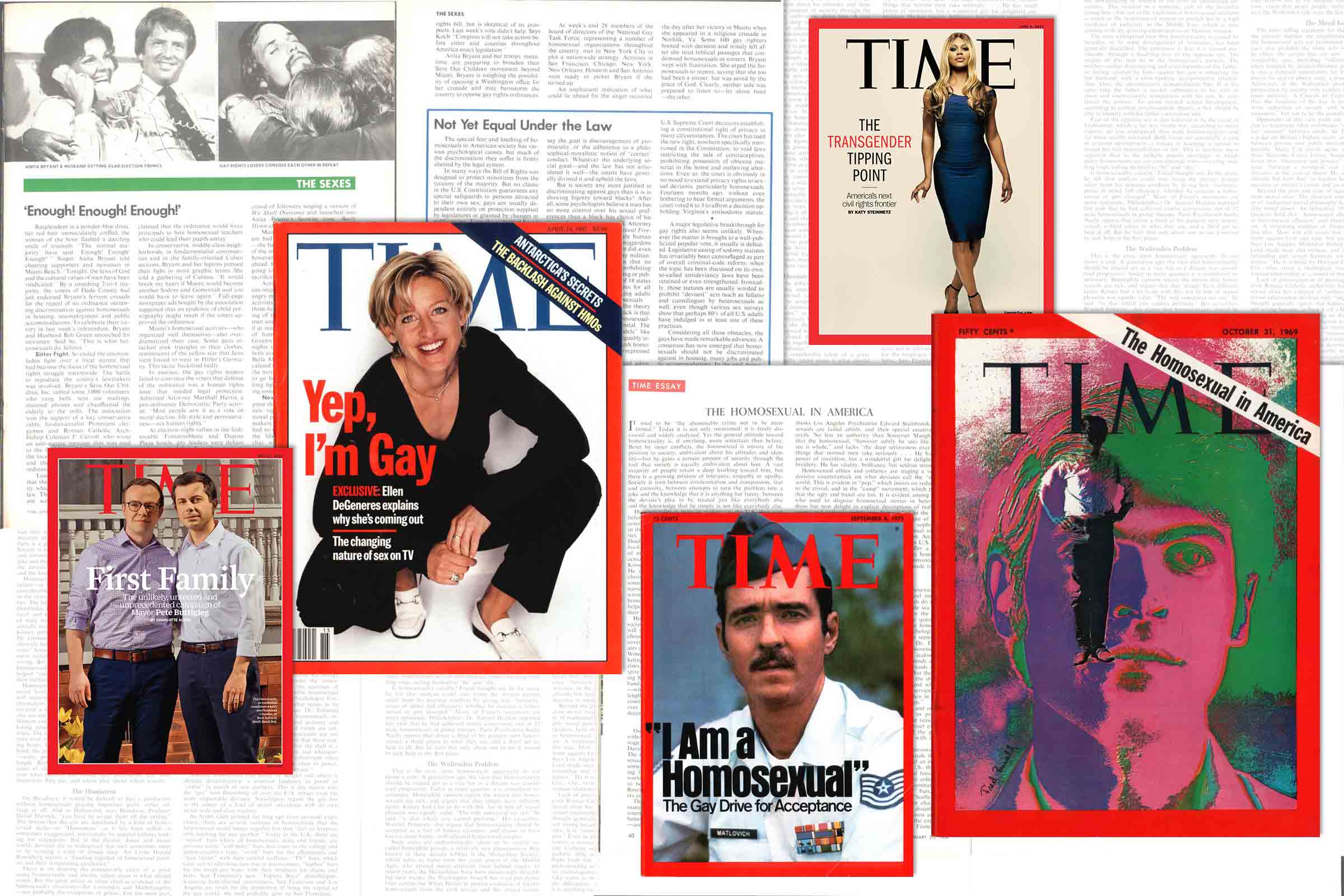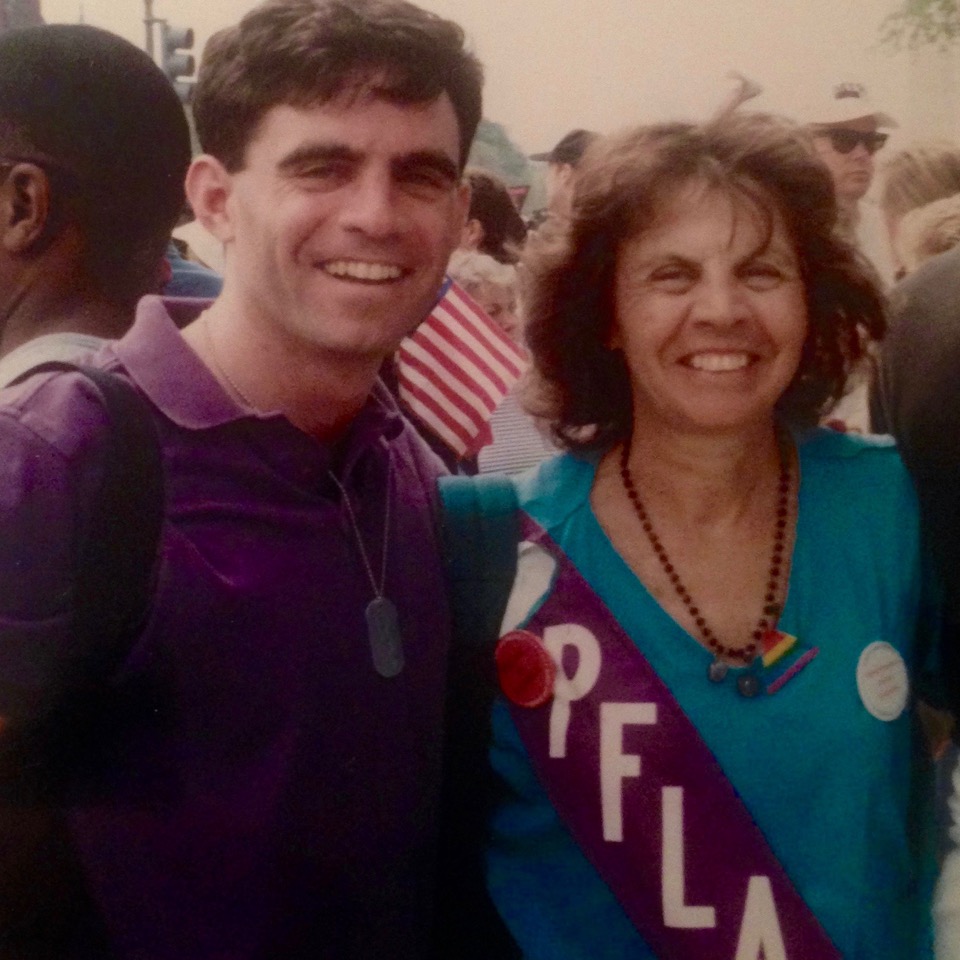How TIME’s Reporting on Gay Life in America

LGBTQ issues on the cover of TIME in (L-R) 2019, 1997, 1975, 2014 and 1969 TIME
BY ERIC MARCUS
Editor’s note: At TIME, we aim to apply the same scrutiny to ourselves that we do to the world. In that spirit, TIME is publishing this article by Eric Marcus, author of Making Gay History.
TIME magazine helped me come out to my mother. Inadvertently. It was June 1977 and I was back in home Queens, N.Y., from my first year at Vassar College. At school I’d haltingly made my way out of the closet — transitioning from a first-semester girlfriend to a second-semester boyfriend and torturing myself (and the girlfriend and boyfriend both) over knowing what I wanted and hating who I was because I’d failed to drive those feelings away.
Over lunch one afternoon at our kitchen table, with the latest issue of TIME turned to an article about Anita Bryant’s successful campaign to repeal a gay-rights bill in Dade County, Fla., I raged over the injustice of both Bryant’s assertion that gay people were a danger to children and the cowardly legislators who caved to prejudice and ignorance. Unknowingly, my red-faced outrage offered another clue to my mother that there was more than a little self-interest at stake for me in the fate of the gay civil-rights movement. Weeks later, she would ask me if I was gay.

June 20, 1997 TIME article about Anita Bryant’s campaign to repeal a gay-rights bill in Dade County, Fla.
It wasn’t until more than a decade later, when I began researching an oral-history book on what was then called the gay and lesbian civil-rights movement, that I realized that TIME magazine had also played a role in shaping how my mother thought of homosexuals — and how she’d come to view her teenaged gay son.
In my research, as I struggled to gain an understanding of why people saw homosexuals as sick, sinful and criminal, I stumbled on a 1966 essay in TIME that just about burned the skin off my face as I read it. I think it was meant as a meditation on what to make of the then-growing visibility of gay life in America. But while it’s couched as enlightened analysis, it now reads as shockingly regressive. (There was no byline, which was the norm for the magazine at the time.) To this day, there are words and phrases from that essay that I can recite from memory: Deviate. Witty, pretty, catty, and no problem to keep at arm’s length. Caused psychically, through a disabling fear of the opposite sex. A case of arrested development. A pathetic little second-rate substitute for reality, a pitiable flight from life. No pretense that it is anything but a pernicious sickness. Had my mother read that essay? Did she recall those words when I responded to her question with a shaky “yes”?
As I came to discover, TIME wasn’t alone. The media in those years, as is most often the case today, reflected society’s prevailing views about homosexuals. Back then, homosexuality was still considered a treatable mental illness, sexual relations between two people of the same sex could get you arrested in almost every state, and thousands — perhaps tens of thousands — of gay men and lesbians had been hounded out of federal employment since President Eisenhower signed an executive order in 1953 banning them from government jobs. In New York, a state law about “disorderly” conduct was interpreted as making it illegal to serve known homosexuals alcohol, and the police routinely raided gay bars.
The now-celebrated 1969 Stonewall uprising — triggered by a police raid of the Stonewall Inn gay bar — which is being marked this month by 50th anniversary celebrations, marches and protests, got a particularly pungent headline in the New York Daily News: “Homo Nest Raided, Queen Bees Are Stinging Mad.” The Village Voice, an alternative downtown newspaper, published an article in the immediate aftermath of the first night of rioting in which the reporter used a slur to refer to the uprising’s participants, earning the Voice, just days after the start of the uprising, one of the first public protests that would come to characterize the newly militant era of “gay liberation.”
TIME, which didn’t cover the uprising, gave prominent play to the rage and wave of activism unleashed in the weeks and months that followed. The Oct. 31, 1969, cover story was headlined “The Homosexual: Newly Visible, Newly Understood.” The magazine got the “newly visible” part right. The piece displays an overall attempt at straightforward reporting, a marked change from the tone of three years prior. And yet the picture the article painted of the “newly understood” homosexual was still dripping with sarcasm and contempt. One section of the report noted several “types” of homosexuals: “The Blatant Homosexual,” “The Secret Lifer,” “The Desperate,” “The Adjusted,” “The Bisexual,” “The Situational-Experimental.” After describing these different categories, the writer notes: “The homosexual subculture, a semi-public world, is, without question, shallow and unstable.”
Although that cover story also said some comparatively nice things about homosexuals, is it any wonder members of the newly formed Gay Liberation Front and the Daughters of Bilitis (an organization for lesbians founded in 1955 in San Francisco) picketed the Time-Life building after its publication? On Nov. 12, 1969 — my 11th birthday — demonstrators handed out leaflets, which read: “In characteristic tight-assed fashion, Time has attempted to dictate sexual boundaries for the American public and to define what is healthy, moral, fun, and good on the basis of its own narrow, outdated, warped, perverted, and repressed sexual bias.” Gay people weren’t going to take it anymore.
When I told my mother eight years later that yes, I was gay, she just looked at me with a blank stare. Was she trying to figure out what kind of homosexual I was? A no-longer-secret lifer? Desperate? An experimenter? Definitely not adjusted. In truth, I was a depressed gay teenager who feared that his life was ruined because of this one, immutable flaw. But I wasn’t about to tell my mother that. I responded with a question of my own: “Do you feel guilty?” I’d come to understand from the research I’d done in the Vassar College library that parents of gay children often felt that it was their own fault (also thanks to TIME and all the other news outlets and so-called experts who blamed homosexuality on a dominant mother and passive father). My mother said that she didn’t feel guilty, that she was disappointed. I would rather she had felt guilty. Her disappointment left me in tears.
In the years that followed, change came — but not rapidly, and with more effort and heartbreak than I’d imagined it would take. TIME, like every other major news outlet, shifted away from parroting society’s prejudice and misunderstanding to more honest and balanced reporting. Even before my mother asked me that fateful question, TIME had published a cover story on Leonard Matlovich, who was challenging the ban on gay people serving in the military. That and subsequent cover stories — the 1997 Ellen DeGeneres “Yep, I’m Gay” cover or the 2014 Laverne Cox cover about transgender civil rights, for example — helped reshape in a positive way how people like me thought of ourselves and how the rest of the world saw us.

Marcus and his mother at the 1993 March on Washington for Lesbian, Gay, and Bi Equal Rights and Liberation
My mother came around, too, and by the early 1990s was an activist in her own right, volunteering to lead a support group for gay men whose partners had died from AIDS and helping found the Queens chapter of PFLAG (once known as Parents, Families and Friends, of Lesbians and Gays). Mom died 15 years ago and I wonder what she would have made of the recent TIME cover story on presidential candidate Pete Buttigieg and his husband Chasten under the headline “First Family.”
Actually, I don’t have to wonder. Knowing my mother she’d have the magazine’s cover taped to her refrigerator — her makeshift vision board — and would be on the phone to me, wanting to know if I could get her tickets to the inauguration.
Eric Marcus is the author of Making Gay History: The Half-Century Fight for Lesbian and Gay Equal Rights and the founder and host of a podcast of the same name. Learn more at www.makinggayhistory.com.
No comments:
Post a Comment